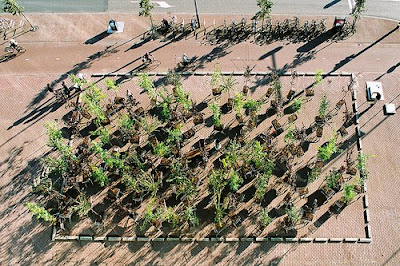
As artist's tools go, Trevor Paglen's are unusual: a camera with a 7000mm telescope lens, FOIA requests, a log of airplane N-numbers. An experimental geographer at UC Berkley, Paglen makes art that is equal parts social science and conceptual art, but geared toward a more political task: capturing fleeting glimpses of the U.S. military's "black world."
Hidden behind razor wire, these secret projects—which account for around $30 billion of the government's annual budget—can be gleaned through the few interfaces between the "black" and "white" worlds, whether it's the fences surrounding sites like the Tonopah Test Range or public filings by CIA front businesses. In Torture Taxi, Paglen's book about CIA "extraordinary rendition" flights, he quotes from Arthur Conan Doyle's first novel. "From a drop of water a logician can infer the possibility of an Atlantic or Niagara without having seen or heard of one or the other."
One project, a wall covered with code names for thousands of recent black ops, suggests the size of the body of water Paglen's peering into—not to mention its murkiness. With little to go on, we're left to guess what jobs operations like "Rugged Vortex" or "Rivet Rider" are charged with. A similar series presents framed signatures, like that of Colleen Bornt, a board member of Premier Executive Transport. The handwriting is wildly different each time, which is fitting since she's a ghost, a fictional employee of a CIA front company created to conduct torture flights.
The most compelling glimpse "inside" is through Paglen's collection of black-op uniform patches. To be worn only in classified facilities (but not classified themselves), these 100 emblems are a mash-up of pop culture references, military machismo, and secret-society mumbo-jumbo, bearing references to everything from an Insane Clown Posse album cover to the 1972 porn film Behind the Green Door. The patch for a squadron of planes that ran nighttime deliveries between aerospace contractors and secret sites shows a moon and a question mark, with the embroidered acronym "NOYFB"—None of Your Fucking Business.
The closest Paglen gets to more aesthetic contemporary art is with his photos of military bases. Shot across scalding desert from as far away as 20 miles, the photos become abstractions, part Gerhard Richter painting, part Bigfoot sighting. "The classic iconography of mystery is things that almost make sense," Paglen tells me, "but it's crucial they don't make sense.
"They're blurry. They're indistinct," he says, underscoring the main point in his work: "I can tell you what you're seeing, but you shouldn't trust me, either."
















































